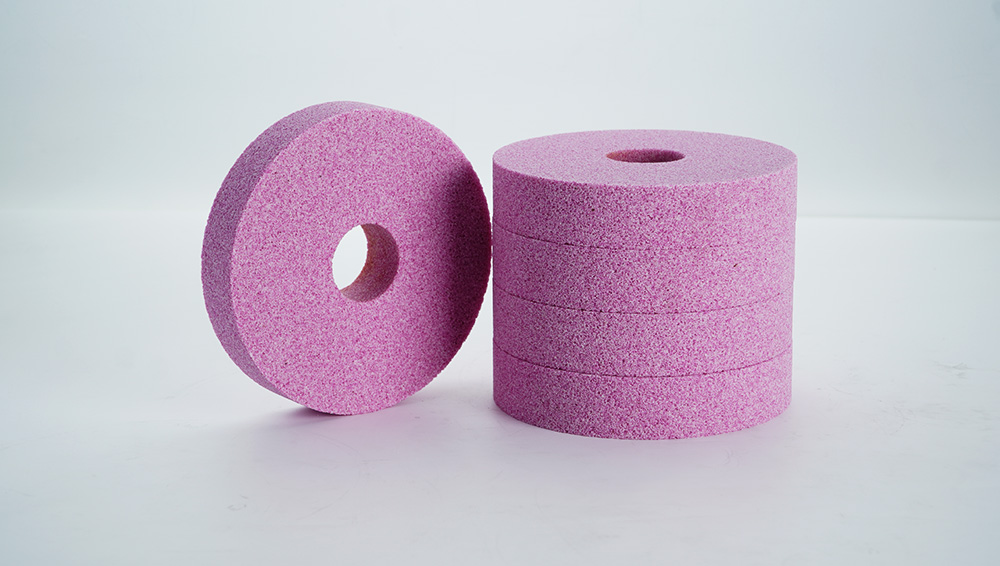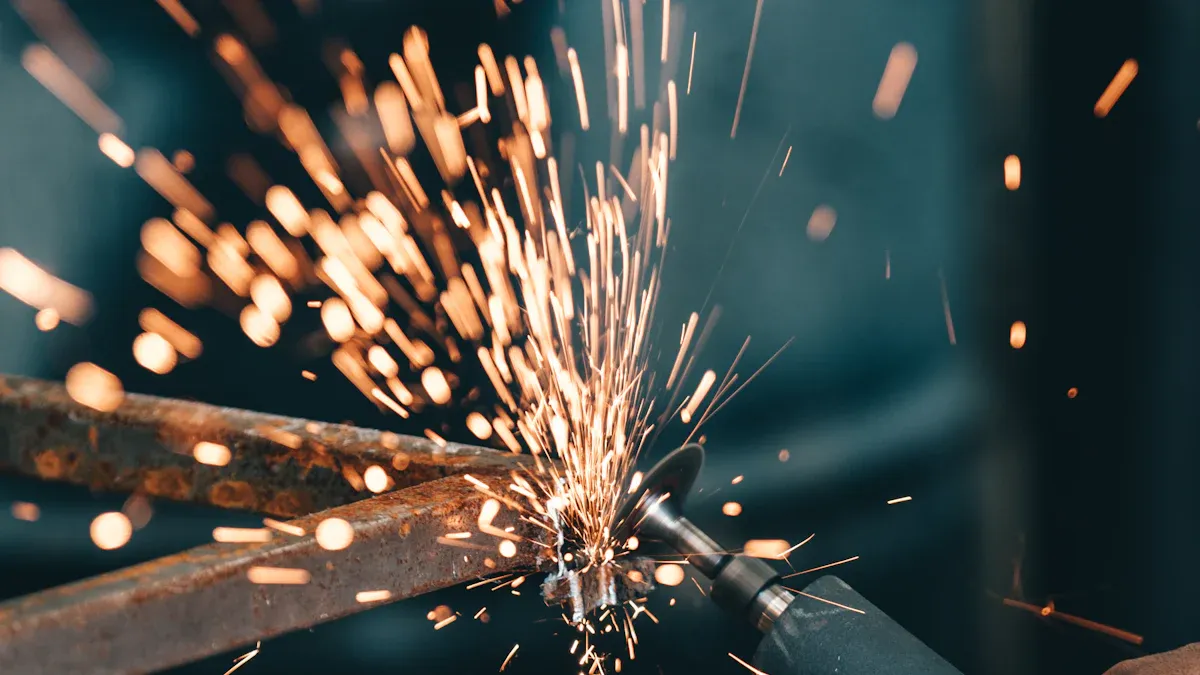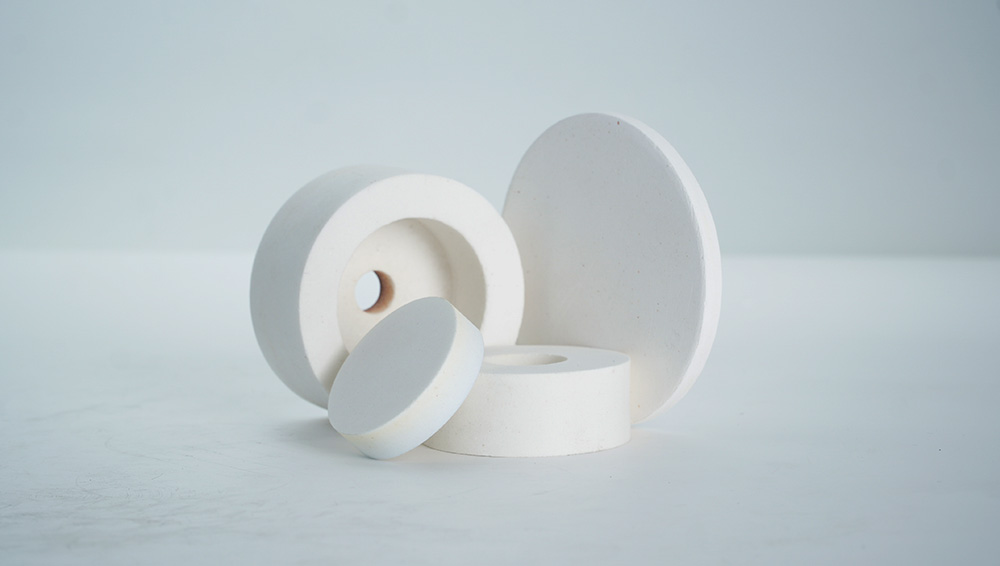You often see aluminum oxide grinding wheels in workshops. They are popular because they last long and do not cost much. They also work well. When you use an aluminum oxide wheel, you see it works well on metal. It is good for steel and other ferrous metals. These grinding wheels can do hard jobs. They cost less than superabrasive wheels. You get good results on most metal grinding jobs. Sometimes, these wheels work better than silicon carbide. But aluminum oxide grains wear down and get dull after some time. You need to dress the wheel often. This keeps it sharp and gives a smooth finish.
Key Takeaways
-
Aluminum oxide grinding wheels can be used on many metals. They work on steel, iron, aluminum, and brass. This makes them useful for many jobs.
-
These wheels cost less than superabrasive wheels. They also last a long time. They give good value for most metal grinding work.
-
Dress the wheel often to keep it sharp. Use the right grit size for your job and material.
-
Control heat when you grind by using coolant. Use the right speed and light pressure. This helps stop damage to your work and wheel.
-
Always follow safety rules. Wear protective gear. Check the wheel for damage. Use the right wheel for your material.
Pros of Aluminum Oxide Grinding Wheel

Versatility
You can use an aluminum oxide grinding wheel on many metals. It works for steel, iron, and other ferrous metals. You can also use it on non-ferrous metals like aluminum, brass, copper, nickel, and titanium. This abrasive can even work on some masonry and stone. Because of this, you can use the same wheel for many jobs in your shop. If you need to grind, smooth, blend, or remove rust, this wheel is a good pick. You can use it with bench grinders, angle grinders, and surface grinders. The aluminum oxide abrasive is tough, so it works on both soft and hard metals. You just need to choose the right grit size for your job.
Tip: Always read the wheel label. Make sure it matches your metal and grinder.
Here are some materials you can use with aluminum oxide grinding wheels:
-
Steel (including tool steel and stainless steel)
-
Cast iron
-
Aluminum
-
Brass
-
Bronze
-
Copper
-
Nickel alloys
-
Titanium
-
Masonry and natural stone
When you compare it to silicon carbide or CBN wheels, aluminum oxide gives a good mix of toughness and hardness. This makes it useful for many grinding jobs.
|
Property |
Aluminum Oxide |
Silicon Carbide |
CBN (Cubic Boron Nitride) |
|---|---|---|---|
|
Hardness |
Moderate, tough |
Hard, brittle |
Highest |
|
Versatility |
Very versatile |
Specialized |
Specialized |
|
Cost |
Affordable |
More expensive |
Most expensive |
|
Best Use |
Metals, wood, general |
Non-metallic, soft |
Hardened alloys |
Cost-Effectiveness
You save money when you pick an aluminum oxide grinding wheel. These wheels cost much less than superabrasive wheels like CBN or ceramic. In many shops, you need to watch your spending. Aluminum oxide wheels give good results for a low price. Even though they may not last as long as some high-end abrasives, you can buy more for the same money. This makes them a smart choice for small shops and for jobs that do not need a super fine finish.
Note: In factories, aluminum oxide grinding wheels can be up to 72% cheaper than CBN wheels. This big price gap helps you save money, especially if you grind steel or do general metal work often.
Durability
Aluminum oxide grinding wheels last a long time. The abrasive grains are hard and strong. They can handle tough grinding jobs without wearing out too fast. You get a longer wheel life than with some other abrasives, like silicon carbide. The wheel does not rust because it has little iron. This helps keep your tools and workpieces clean. While zirconia alumina and ceramic wheels last even longer, aluminum oxide gives you a good mix of durability and price.
|
Abrasive Type |
Durability |
Lifespan |
Cost |
|---|---|---|---|
|
Aluminum Oxide |
Good |
Moderate |
Affordable |
|
Zirconia Alumina |
Better |
Longer |
Mid-range |
|
Ceramic |
Best |
Longest |
Expensive |
Consistent Performance
You get steady results with an aluminum oxide grinding wheel. The abrasive grains break down as you use the wheel. This shows new, sharp edges. The wheel keeps cutting well and does not clog fast. You can count on a sharp first cut and a smooth finish. The wheel works for both heavy material removal and fine finishing, depending on the grit size you pick. Many users say these wheels give reliable finishes and good material removal over time.
-
The strong bond in the wheel holds the abrasive grains tight.
-
The wheel design lets coolant flow, which helps stop overheating.
-
You can use different grit sizes for rough or fine grinding.
-
Dressing the wheel often keeps it sharp and helps it work well.
User-Friendly
You will find aluminum oxide grinding wheels easy to use. Both beginners and experts like them. The wheels fit many types of grinders. They are simple to put on and balance. The special bond design cuts down on vibration, so you feel safer and more comfortable. The wheels make fewer sparks, which helps keep your workspace safe. You can find many sizes and shapes, so you can pick the best one for your job. The wheels are also easy to dress and take care of.
-
Fewer sparks make things safer.
-
You can often get help and support after buying.
Tip: Try different types like white or pink aluminum oxide wheels. These can help lower heat and wear, giving you even better results for some jobs.
Cons of Aluminum Oxide Abrasives

Hard Material Limitations
You might see that aluminum oxide abrasives do not work well on very hard materials. When you try to grind carbide or hardened steel, the grains get dull fast. This means you remove less material and need to change the wheel more often. Other abrasives like silicon carbide, zirconia, or ceramic work better for these tough jobs. Aluminum oxide has a Mohs hardness of 9, so it is strong but not the hardest. It lasts longer on softer metals, but it cannot handle very hard materials as well.
-
Aluminum oxide grinding wheels do not cut carbide or hardened steel as well.
-
The grains get dull quickly, so you must dress or change the wheel more.
-
You may spend more time grinding and your results may not be as exact.
-
For jobs that need high precision or deal with hard metals, pick abrasives that are harder and last longer.
Tip: Use aluminum oxide abrasives for regular steel, but switch to silicon carbide or CBN wheels for carbide or hardened steel.
Heat Generation
Grinding with aluminum oxide wheels makes a lot of heat. The friction between the abrasive and the metal raises the temperature. If you do not control this heat, your workpiece can get damaged. High heat can burn, crack, or change the metal. You might see color changes or lose the right shape. Heat can also make the wheel glaze, so it does not cut well.
To keep things cool, you should:
-
Use coolant or lubricant to lower the heat.
-
Press lightly or with medium force.
-
Take breaks so the wheel and metal can cool.
-
Clean the wheel to stop buildup.
-
Move the wheel smoothly and do not stay in one spot.
-
Pick wheels made for your material.
-
Make sure your workspace has good airflow.
-
Wear the right safety gear.
Note: Keeping heat under control helps your workpiece stay accurate and keeps your abrasive wheel in good shape.
Wear Rate
Aluminum oxide abrasives wear out over time, especially on hard metals. The grains break off or get dull, so you need to dress the wheel often. If you skip this, the wheel will not cut well and your finish will not look good. The wheel can also lose its shape, making it hard to get exact results. Compared to ceramic or CBN wheels, aluminum oxide wheels need more care and do not last as long on tough jobs.
-
Dressing the wheel often keeps it sharp.
-
Dull grains mean the wheel does not cut as well.
-
Changing wheels more often costs more and takes time.
Surface Finishing
You can get a good finish on steel and iron with aluminum oxide wheels, but there are limits. The finish depends on the grit size, wheel hardness, and how you grind. A 60-grit wheel works well for most steel jobs. If you use the right method—cutting with the edge and moving quickly—you can get a smooth surface with little heat damage. Coolant helps stop cracks and keeps the finish clean.
But aluminum oxide wheels get dull over time. This makes it harder to get a very fine or shiny finish, especially if you need tight measurements. Ceramic and CBN wheels stay sharp longer and give better, more even finishes. If you want the best surface, you might want to use a different abrasive.
|
Abrasive Type |
Surface Finish Quality |
Maintenance Needed |
Best Use Cases |
|---|---|---|---|
|
Aluminum Oxide |
Good (general) |
Frequent dressing |
Steel, iron, general grinding |
|
Ceramic |
Excellent |
Less frequent |
Hard steels, precision work |
|
CBN |
Superior |
Minimal |
Hardened steel, high-precision |
Tip: For a better finish, use light cuts, coolant, and dress your wheel often.
Safety Concerns
Using aluminum oxide abrasives can be risky. The wheel can break if you put it on wrong or press too hard. Pieces and sparks can hurt your eyes or skin. Grinding also makes dust, which can hurt your lungs if you breathe it in. Loud noise from grinding can damage your hearing.
-
Wheel breaking and pieces flying
-
Eye and skin injuries from small bits
-
Dust and fumes that can cause breathing problems
-
Loud noise that can hurt your ears
-
Wrong mounting or too much force can make the wheel fail
You should always wear safety glasses, gloves, and a mask. Use ear protection if it is loud. Make sure the wheel guard covers at least half the wheel. Stand to the side when you start the grinder, and let the wheel reach full speed before you begin. Only grind on the right surfaces, and never force the wheel.
|
Standard/Regulation |
Description |
Key Requirements |
|---|---|---|
|
Abrasive wheel machinery safety |
Guarding, mounting, maintenance, ring testing |
|
|
ANSI B7.1 |
Safety code for abrasive wheels |
Use, care, inspection, storage, handling |
|
OSHA 29 CFR 1910.133 |
Eye protection |
Mandatory during grinding |
|
OSHA 29 CFR 1910.134 |
Respiratory protection |
Use respirators for dust/fumes |
|
OSHA 29 CFR 1910.95 |
Hearing protection |
Required for high noise levels |
Alert: Always follow safety rules and wear the right safety gear when working with aluminum oxide abrasives.
User Considerations for Aluminum Oxide
Best Use Cases
Aluminum oxide wheels work best when you want steady results and the wheel to keep its shape. These wheels are good for jobs like sharpening, smoothing, and shaping metal. You can use them on iron, steel, aluminum, brass, bronze, and copper. They can handle fast speeds and high heat, so your workpiece does not get damaged. Pick coarse grits if you need to remove a lot of material. Use fine grits if you want a smooth or shiny finish. White wheels are best for steels that get hot easily. Pink and ruby wheels are good for tool steels. Many toolrooms and metal shops use these wheels for rough work and for making things more exact.
-
Sharpening, smoothing, and shaping metal
-
Grinding aluminum and other metals
-
Working with tool steel and high-speed steel
-
Getting smooth finishes with fine grits
-
Jobs where you do not want heat damage
Tip: Always pick the right grit and wheel type for your job and material.
When to Avoid
There are times when you should not use these wheels:
-
Do not use the wheel if it has cracks, chips, or is worn unevenly.
-
Stop using it if metal builds up on the wheel or it loses its shape.
-
If you hear loud sounds or see a bad finish, stop right away.
-
Never use the wrong wheel for your metal or go over the speed limit.
-
Keep wheels in a dry, safe place so they stay in good shape.
For very hard materials like carbide or for jobs that need to be very exact, use a different abrasive. Silicon carbide, ceramic, or diamond wheels are better for these tough jobs.
|
Abrasive Type |
Best For |
|---|---|
|
Silicon Carbide |
Carbide, cast iron, hard metals |
|
Stainless steel, hard ferrous metals |
|
|
Diamond |
Extremely hard materials, masonry |
Maximizing Finishing Results
To get the best finish, check your wheel before you use it. Pick the right grit and hardness for your job. Dress the wheel often to keep it sharp and in the right shape. Use steady pressure and the right speed. Clean the wheel after you dress it and always follow safety rules. Doing these things helps you get smooth surfaces and makes your wheel last longer.
-
Check for damage before using
-
Dress the wheel often
-
Use steady, even pressure
-
Run at the right speed
-
Clean after dressing
Note: Using diamond tools to dress and adding coolant can help your wheel last longer and give a better finish.
When should users choose CBN grinding wheels over aluminum oxide wheels?
Pick CBN wheels if you need very exact work, long-lasting wheels, and fast cutting on hard ferrous metals. CBN wheels are best for finishing and sharpening tools, especially if you do a lot of work or need things to be very exact. They do not get hot or wear out quickly, so you spend less time fixing them. Use aluminum oxide wheels for rough shaping or if you want a smoother finish on softer metals. CBN wheels might leave a rougher finish, but they last longer and cut faster.
|
Condition |
CBN Wheels |
Aluminum Oxide Wheels |
|---|---|---|
|
✔️ |
|
|
|
Hard Ferrous Materials |
✔️ |
|
|
Rough Shaping |
|
✔️ |
|
Smoother Finish |
|
✔️ |
|
Long Wheel Life |
✔️ |
|
Aluminum oxide grinding wheels give you solid performance for many metalworking tasks. You get good value, steady results, and easy use. Watch for heat, wear, and safety risks. Always match the wheel to your material. Check for damage before each use. If you need to grind hard metals or want a longer-lasting wheel, try CBN or ceramic options.
Tip: Always wear safety gear and follow best practices to protect yourself and your work.
FAQ
What materials can you grind with aluminum oxide wheels?
You can grind steel, iron, aluminum, brass, bronze, copper, and some stone. These wheels work best on ferrous metals. You should not use them on carbide or glass.
How do you keep an aluminum oxide wheel sharp?
You should dress the wheel often. Use a diamond dresser or dressing stick. This removes dull grains and keeps the wheel cutting well.
Why does your workpiece get hot when grinding?
Friction between the wheel and metal creates heat. If you press too hard or grind too long, the workpiece gets hot. Use light pressure and coolant to keep things cool.
How do you know when to replace your grinding wheel?
Check for cracks, chips, or uneven wear. If the wheel does not cut well after dressing, you should replace it. Always inspect before each use.
Can you use aluminum oxide wheels for sharpening tools?
Yes, you can use these wheels to sharpen knives, chisels, and other tools. Pick a fine grit for a smooth edge. Always follow safety rules when sharpening.
Contact Us
For More Grinding Solution or Customized Abrasive Tools

